Morphological study and molecular epidemiology of Anisakis larvae in mackerel fish
Vipavinee Cheypanya, Pheravut Wongsawad, Chalobol Wongsawad, Nattawadee Nantarat,5
1Graduate Master's Degree Program in Biology, Faculty of Science, Chiang Mai University, Mueang, 50200, Thailand
2Department of Biology, Faculty of Science, Chiang Mai University, Mueang, 50200, Thailand
3Research Center in Bioresources for Agriculture, Industry and Medicine, Faculty of Science, Chiang Mai University, Chiang Mai 50200, Thailand
4Economic Plant Genome Service Centre, Faculty of Science, Chiang Mai University, Chiang Mai 50200, Thailand
5Environmental Science Research Center (ESRC), Chiang Mai University, Chiang Mai, 50200, Thailand
ABSTRACT
KEYWORDS: Anisakis; Mackerel; Thailand; Phylogenetic tree;Taxonomy; Species delimitation
1. Introduction
Mackerels (Scomber and Rastrelliger) are members of the family Scombridae. They are epipelagic and neritic species and an important commercial fish for tropical and temperate zones. Blue mackerel [Scomber (S.) australasicus] is a plankton feeder, and adults likewise feed on small fish and squids. Their distributions are in the Western Pacific Ocean (along with Australia, New Zealand, north China, and Japan) and the Eastern Pacific Ocean (off Mexico).Indian mackerel [Rastrelliger (R.) kanagurta] occurs on the surface water that temperature is at least 17 ℃ and changes its dietary habit with its growth; juveniles feed on phytoplankton and small zooplankton, while adults feed on macroplankton. Its distribution is in the Indo-West Pacific (along South Africa, the eastern Red Sea,Indonesia, off northern Australia, and the eastern Mediterranean) [1].They migrate from one place to the place where nutrients are profuse[2,3]. The mackerel is the most commercially important fish in Thailand[4]. Many reports have shown that Anisakis infect mackerel, especially horse mackerel (Trachurus trachurus), blue mackerel (S. australasicus), chub mackerel (S. japonicus), and Indian mackerel (R. kanagurta)[5-8]. However, in Thailand, there are only a few reports of Anisakis larvae in marine fish and squid[9-11].
Anisakis is nematode belonging to the Anisakidae family. It is typically found in the adult stage in marine mammals[12,13], for example, whales and dolphins. The third-stage larvae of Anisakis spp. can infect humans that eat raw fish[12], which can cause anisakiasis or anisakiosis. There are various reports of Anisakis that infect humans including Anisakis (A.) pegreffii and A. simplex(sensu stricto) [13,14]. These nematodes can penetrate the stomach wall and cause gastrointestinal symptoms including stomach pain,vomiting, and nausea[12,13]. Additionally, Anisakis infection is possibly a risk factor for the development of gastrointestinal cancer or tumor[15,16]. Numerous studies on Anisakis third-stage larvae using light and scanning electron microscopes (SEM) have shown important characteristics, for example, the boring tooth, ventriculus,and mucron[17-20]. However, the information on Anisakis larvae is not sufficient for the identification of species, and Anisakis larvae taxonomy is hardly explicit.
Molecular systematics has provided new characteristics for finding parasite species, addressing concerns that morphological characters may not be enough to definitively identify all species and supporting the advantages of molecular procedures for studying parasite systematics and evolution[21]. Nevertheless, the taxonomic status of Anisakis spp. larvae is still puzzling. Consequently, molecular techniques are being used for the identification of Anisakis larvae.Various genes have been employed to identify the parasites,including the internal transcribed spacer region (ITS), cytochrome oxidase subunitⅠ(cox1), and cox2[22]. The cox2 gene is a very powerful tool applied for elucidating population genetic structure and inter- and intra-specific levels of Anisakis larvae, such as A.simplex (s.s.), A. typica, A. pegreffii, A. ziphidarum, A. physeteris, A.brevispiculata, and A. paggiae[10,23-25]. Species delimitation can incorporate character states and genetic distance analyses to identify the parasite and provide cryptic speciation in various parasites,including Anisakis[26-29].
This study aimed to examine Anisakis larvae in blue mackerel(S. australasicus) and Indian mackerel (R. kanagurta) sold from a department store in Chiang Mai, Thailand using light microscope,SEM, molecular phylogeny, and species delimitation methods for confirmation of the species, determining the nematodes, studying the relationship, and delimiting the species. Furthermore, we also aim to describe the epidemiology (prevalence, mean intensity, and mean abundance), rate of infection, and specificity in the host of Anisakis larvae in mackerel fish. Additionally, this study will show the risk of infection of Anisakis found in mackerel fish that were sold from a department store in Chiang Mai province, northern Thailand, far from the seashore.
2. Materials and methods
2.1. Ethical approval
All experiments were performed following the guidelines approved by the Institute of Animals for Scientific Purposes Development(IAD), and the relevant document (No. U1-07209-2560) was approved by the committee. The guidelines for animal care and use of animals for research, testing, biological production, and teaching in the Kingdom of Thailand were used in agreement with the Animals for Scientific Purposes Act, 2015.
2.2. Collecting of Anisakis larvae
Blue mackerel (S. australasicus) and Indian mackerel (R. kanagurta)were bought from a department store in Chiang Mai province from May 2019 to January 2020. All specimens were immediately transported to the laboratory. A total of 90 fish specimens (45 per species) were measured (body height, body length, and fork length),weighed, and identified[30]. The fish were dissected to examine the body cavity, gastrointestinal tract, and muscle. The muscle was digested[31,32]. The worms were collected under a stereomicroscope.All information was used to determine prevalence, mean intensity,and mean abundance[33], and third-stage larvae were identified[34].All Anisakis larvae samples were used for morphology, SEM, and molecular techniques. Therefore, Anisakis larvae samples from each fish species were eventually processed individually in the molecular studies. The remaining 235 A. pegreffii larvae and 14 A. typica larvae were processed in a morphology and SEM.
2.3. Morphological study
A semi-permanent slide of 214 A. pegreffii larvae and 6 A. typica larvae, whole body, were fixed in 4% formalin and washed with distilled water. A grading alcohol series was applied to specimens and then kept in the glycerin alcohol for morphological study. The specimens were measured for total length and width of the body,length of the esophagus, length, and width of ventriculus, boring tooth length, and mucron length.
2.4. Scanning electron microscopy (SEM)
Samples of 21 A. pegreffii larvae and 8 A. typica larvae, whole larvae, were washed with phosphate buffer (pH 7.4) and pre-fixed using 2.5% glutaraldehyde for 24 h and post-fixed by 1% osmium tetroxide in phosphate buffer for 24 h to use the pass-through SEM method. Samples were dehydrated using an alcohol series and acetone. Then, the samples were dried in a critical point dryer. The samples were mounted on stubs and coated with gold. The sample was observed (structure, mouthpart, cuticle surface, boring tooth,and mucron) and photographed using JEOL JSM-5910LV SEM.
2.5. DNA extraction and sequencing
DNA of individually Anisakis larvae[35] from specimens collected from both fish species were isolated using the chelex method[36]with 5% chelex and 3 μL proteinase K. The 20 μL PCR reaction contained 0.1 μL/mL buffer, 1.5 mM MgCl, 200 μM dNTP, 50 pM each of primer 210 5’CACCAACTCTTAAAATTATC and 211 5’TTTTCTAGTTATATA GATTGRTTYAT[37], 0.5 unit Taq DNA polymerase, 0.69 μL/mL deionized water, and 50 ng DNA. The PCR was performed under the following conditions: initial denaturation at 94 ℃-95 ℃ for 3 min, then 34-40 cycles of 94 ℃ for 30 sec,annealing at 46 ℃-50 ℃ for 1 min, extension at 72 ℃ for 1 min and 30 sec, and a final extension at 72 ℃ for 7-10 min. The PCR products were examined on 1.4% TBE agarose gel electrophoresis stained with RedSafe DNA stain. Finally, the PCR products were purified and sequenced by Ward Medic Ltd. The cox2 genes in this study were deposited in GenBank under accession numbers MN921647 and MN921645. We noted that we did not use the same larvae for the morphological identification, SEM, and molecular analysis.
2.6. Phylogenetic analysis
Sequences were verified by forward and reverse comparisons assembled using MEGA 7[38]. The sample sequences were compared with previous studies for species identification, and the Basic Local Alignment Search Tool (BLAST) from the GenBank database. The results of sequencing were compared with GenBank data. Neighborjoining (NJ), maximum likelihood (ML), and Bayesian inference(BI) were performed based on cox2. The NJ analysis was done using MEGA7 and ML analysis using PhyML 3.0[39] and the Jukes-Cantor model. Bootstrap[40] resampling with 1 000 replicates was applied for both NJ and ML. The BI analysis was done using MrBayes version 3.2.7a[41] with the same model, and tree space was investigated using four chains for each run of a Markov chain Monte Carlo algorithm(MCMC). The BI analysis was run for 1 500 000 generations(heating parameter=0.09), sampled every 100 generations, and burnin=0.25. Convergence was monitored by proving the average standard deviation of the split frequencies (between two runs) below 0.01.
2.7. Species delimitation
The species tree from the cox2 gene was generated fromBEAST v1.10.4.[42]. Species delimitation methods were performed using Poisson Tree Processes (PTP) and Generalized Mixed Yule-Coalescent (GMYC) methods[43]. All methods were run using the webserver (https://species.h-its.org). GMYC methods were performed using single and multiple thresholds[44]. The information for Anisakis spp. in this part is shown in Table 1.
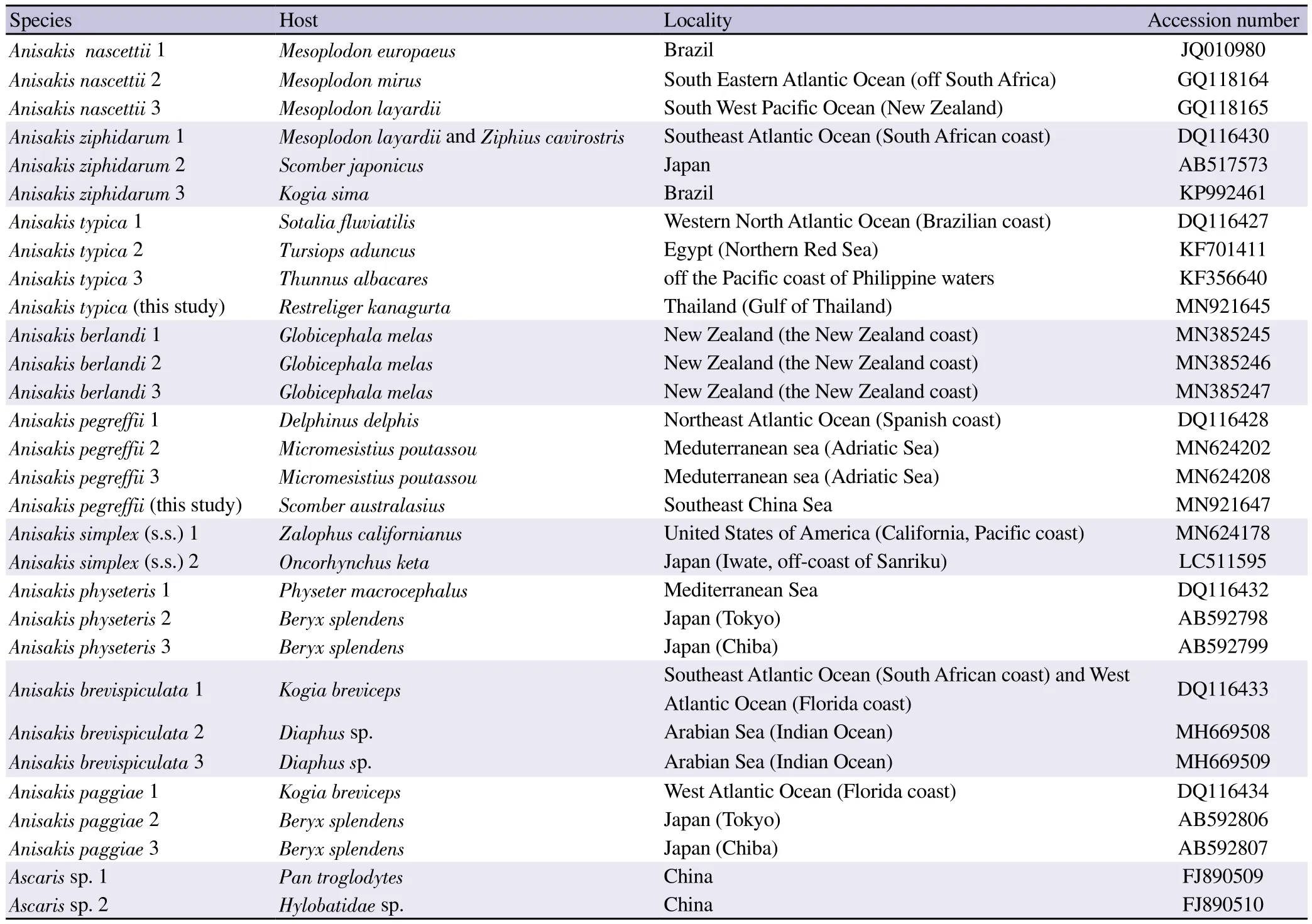
Table 1. Accession number of Anisakis spp. in phylogenetic and species delimitation analyses in this study.
3. Results
3.1. Study of prevalence, mean intensity, and mean abundance
Anisakis larvae (L3) were collected from 35 blue mackerel (S.australasicus) and 6 Indian mackerel (R. kanagurta). Most Anisakis larvae were collected from the body cavity. The prevalence, mean intensity (Mean±SEM), and mean abundance of Anisakis larvae(Mean±SEM) in blue mackerel were 77.78%, 6.74±1.320, and 5.24±1.107, respectively, and in Indian mackerel, these values were 13.33%, 2.50±0.764, and 0.33±0.159, respectively. All parameters of infection from blue mackerel in this study were higher than those were of Indian mackerel. The Anisakis larvae in blue mackerel were chiefly found in the body cavity (98.73%) and occasionally found in the liver (1.27%), while in Indian mackerel, Anisakis larvae were only found in the body cavity (100%).
3.2. Morphological study of Anisakis larvae
The morphology of L3 Anisakis larvae in blue mackerel was investigated using a light microscope. The anterior part of Anisakis larvae showed a boring tooth and poorly developed lips[45]. The ventriculus had a long and cylindrical shape. The posterior part of Anisakis larvae showed a rectal gland and mucron (Table 2). In this study, the boring tooth and excretory pore were found in the anterior part. For the posterior part, an anal opening and mucron were found(Figure 1). In Indian mackerel, L3 Anisakis larvae were investigated using a light microscope. The anterior part of the larvae had poorly developed lips and a boring tooth. The ventriculus was cylindricallyshaped. The posterior part of Anisakis larvae showed a rectal gland and mucron. In this study, the boring tooth and excretory pore were in the anterior part. The posterior part included an anal opening and mucron. The mucron had a cylindrical shape, therefore, it was necessary to identify L3 Anisakis larvae with molecular techniques(Figure 1 and Table 2).

Table 2. Morphometric comparison of L3 Anisakis larvae (mm).
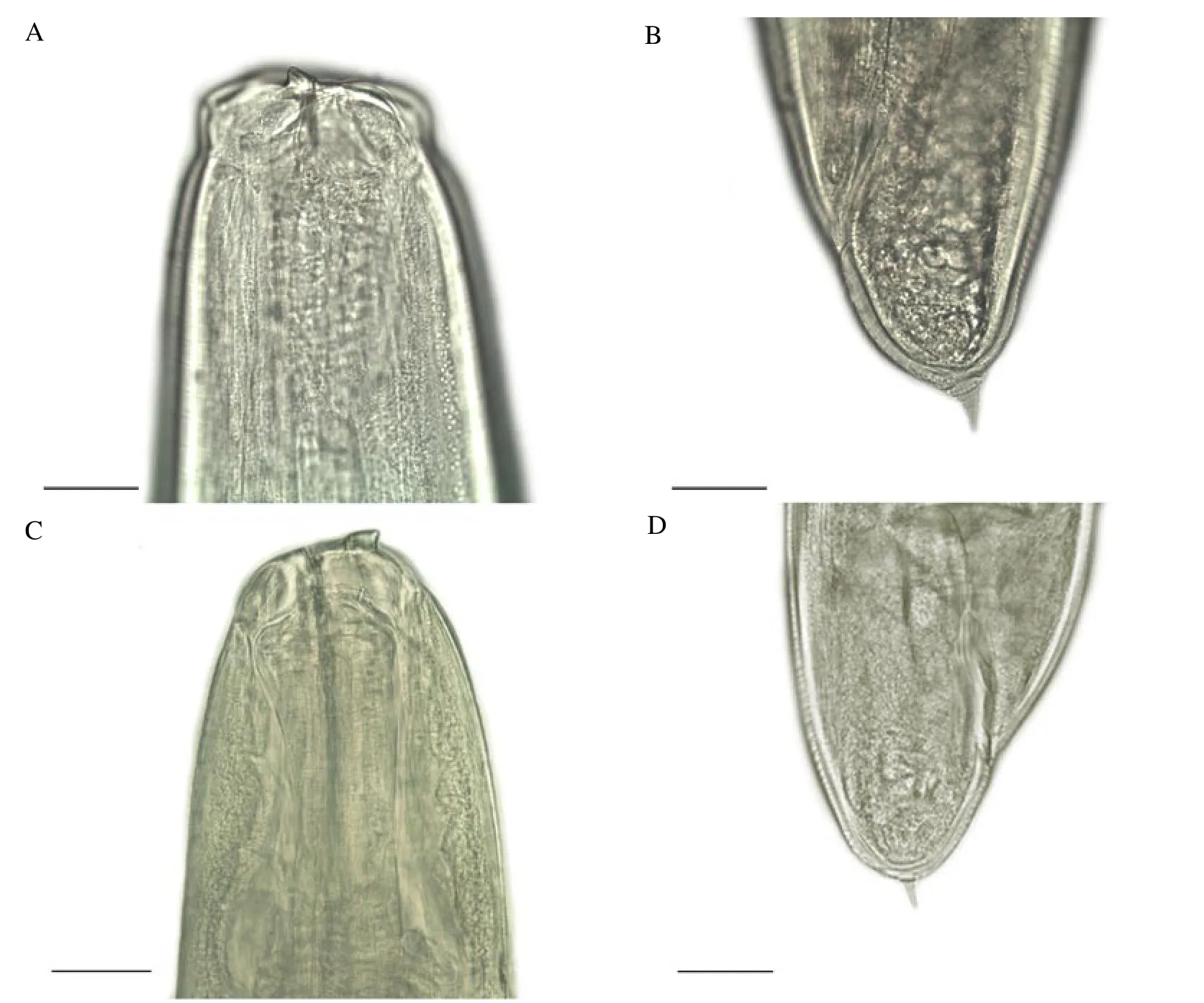
Figure 1. Morphological characteristics of L3 Anisakis larvae visualized using a light microscope (40× magnification). Anisakis pegreffii from blue mackerel shown in A and B and Anisakis typica from Indian mackerel shown in C and D. Scale bar is 50 μm.
The morphological study of L3 Anisakis larvae using SEM in this investigation allowed a comparison of the boring tooth and mucron between this study and a previous study. The result showed that the width and length of the boring tooth and mucron were slightly different. The results showed that measuring the boring tooth and mucron had similar measures, and it was difficult to use those characteristics to identify two species. This study found that the shapes of mucrons were different. A. pegreffii has a cone-shaped mucron, similar to A. simplex (s.s.), as seen in a previous study[46].The mucron from A. typica from this study had a cylindrical shape,similar to a previous study (Figure 2).
3.3. Molecular identification
A total of 429 bp of the cox2 gene were used for phylogenetic analysis. Sequences of the cox2 gene were identified using the BLASTn algorithm from the GenBank database. The percent identities of A. typica in Indian mackerel (accession number KF701411) were 99.30% and 100% with A. pegreffii (accession numbers MK599139, MK598051, MH443136, and MH443129).
3.4. DNA sequence and molecular phylogeny
A phylogenetic tree based on the cox2 gene showed the evolutionary relationships among Anisakis spp. Tree topologies with branches supported by >65% of NJ/ML/BI bootstraps are shown in Figure 3. The inferred topologies strongly supported the monophyly of Anisakis spp. Anisakis was separated into 2 clades that consist of clade A and B. Clade A was also separated into 2 subclades: Clade A1 included A. nascettii, A. ziphidarum, and A. typica, while Clade A2 included A. berlandi, A. simplex (s.s.), and A. pegreffii. Clade B included A. physeteris, A. brevispiculata, and A. paggiae. For this study, Anisakis larvae from blue mackerel were grouped with A.pegreffii (Figure 3). The genetic distance of the cox2 gene fragment within Anisakis species was 0.004-0.035 (average 0.017) by the Kimura 2-parameter model, between-groups was 0.052-0.214(average 0.140), and between-groups, including the outgroup, was 0.052-0.214 (average 0.147).
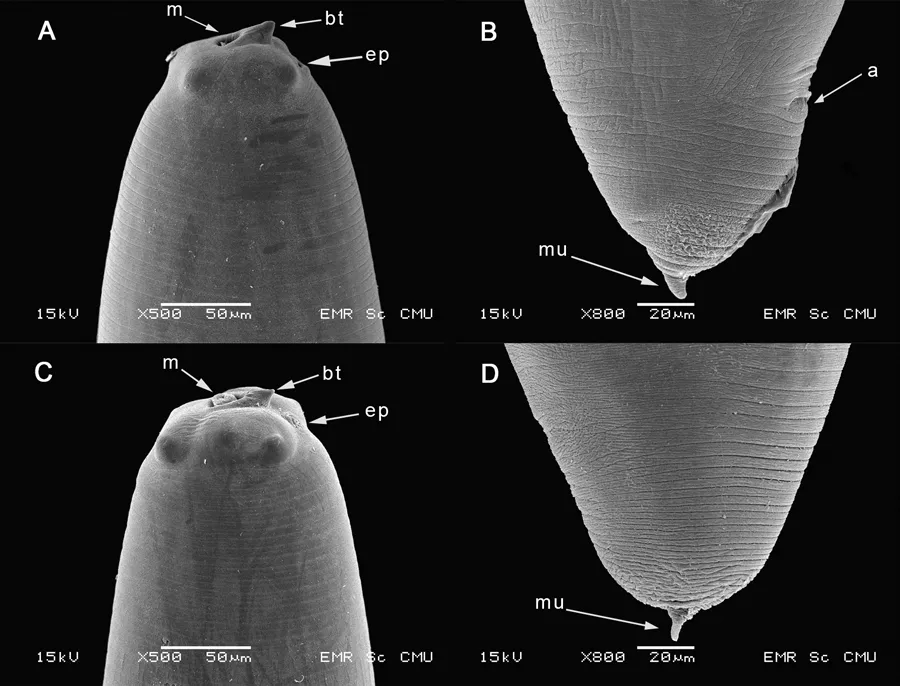
Figure 2. Morphological characteristics of L3 Anisakis larvae by scanning electronic microscopy. Anisakis pegreffii from blue mackerel: A (500× magnification)and B (800× magnification). Anisakis typica from Indian mackerel: C (500× magnification) and D (800× magnification). m: mouth; bt: boring tooth; ep:excretory pore; mu: mucron; a: anal opening.
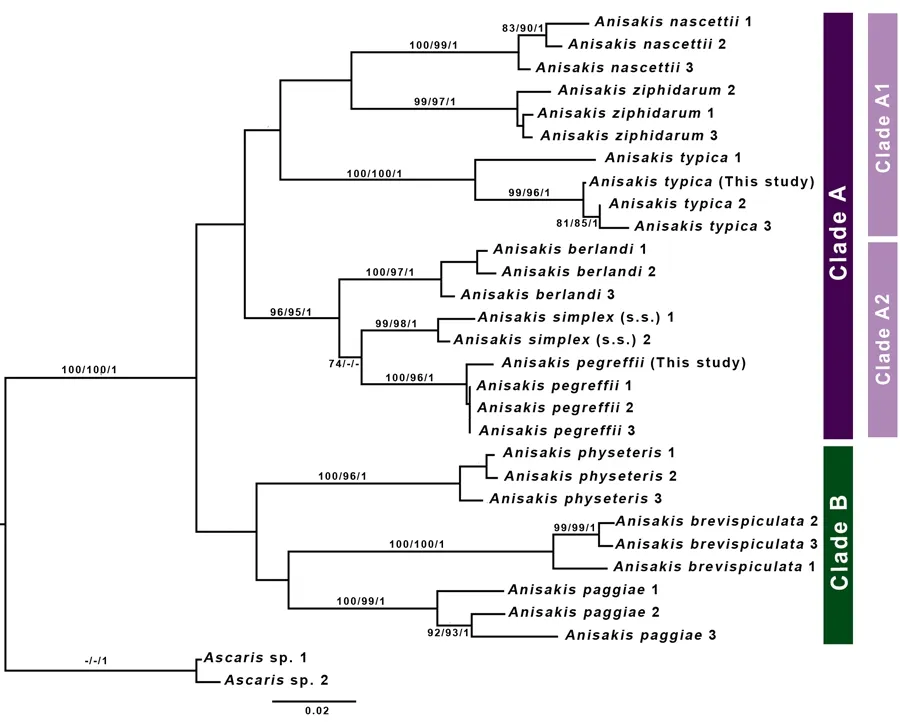
Figure 3. Cox2 phylogenetic tree of Anisakis spp. based on neighbor-joining (NJ), maximum likelihood (ML), and Bayesian inference (BI) methods.
3.5. Species delimitation
All Anisakis species groups in clades 1-9 were supported by two species delimitation methods (bPTP and GMYC, Figure 4).The bPTP and GMYC showed 9 Anisakis species. Both methods supported possible cryptic species within A. typica. Moreover, results of the bPTP method showed the separation of A. brevispiculata and A.typica, while the GMYC method showed the separation of A. paggiae and A. typica.

Figure 4. Species delimitation analyses of Anisakis spp. based on cox2 using bPTP and GMYC. The PSHs are labeled with numbers and letters.
4. Discussion
The study of L3 Anisakis spp. larvae in mackerel fish from a department store in Chiang Mai, Thailand found that the prevalence,mean intensity, and abundance of Anisakis larvae in blue mackerel were higher than in Indian mackerel. The species confirmation with the DNA cox2 gene indicated A. pegreffii in blue mackerel and A.typica in Indian mackerel. The prevalence of infection A. pegrefii in blue mackerel from this study was 77.78%. This was similar to the previous study with 83.33% and 57.2%, and it was determined to be the dominant species[8,19,47]. Additionally, the prevalence of A. typica in Indian mackerel was 13.33%, which was low and similar to the previously reported 17.0% and 5%[48,49]. However, we noted that we used a digestion method with pineapple juice to examine fish for the collection of anisakid larvae that differed from a previous study[50].This is a limitation of the study, and it can also cause different prevalence and abundance of Anisakis larvae in the fish[31,32,51]. The different prevalences of Anisakis spp. can be explained by a location effect and the availability of the definitive hosts[52], and it may be connected to the feeding habits of the fish[45]. Although A. typica was found in lower infections than A. pegreffii, it can be found in many species of mackerel in the world, while A. pegreffii seems to be more specific to their host[13]. Both abiotic (water circulation) and biotic factors including food composition, distribution of final host,climate zones and oceans, geographic distribution, oceanographic conditions, water temperature, and salinity could directly influence the presence of a stable food web and the persistence of the parasite’s life cycle in the sea. These factors may result in enhancing the abundant distributions of hosts belonging to the different trophic levels of their life cycle of A. pegreffii and A. typica. Therefore, this could explain the distribution and infection levels of these parasites in this area[13,48,53]. This study found that A. typica has geographical distribution in warm temperate and tropical water[13], similar to the report from Indonesia[48]; while to the best of our knowledge, A.pegreffii in blue mackerel from this study was the first time found out of the Sea of Japan and the East China Sea[13].
Using a light microscope and SEM in this study, L3 Anisakis larvae from blue mackerel and Indian mackerel were found to have similar characteristics, as seen in a previous study, for example,the boring tooth and ventriculus[45,46,54,55]. However, comparing SEM micrographs from this study and a previous study, it showed different excretory pore form. The excretory pore shape difference between A. pegreffii and A. typica suggested it might be used for identification in the L3 stage larvae. Moreover, in this study, the mucron of A. pegreffii larvae was cone-shaped, but the one in A.typica was cylindrically-shaped, while a previous study found that both A. pegreffii and A. simplex (s.s.) larvae had a cone-shaped mucron[55]. However, the comparison of the measurements of the boring tooth and mucron between this and a previous study using A. pegreffii[8] and A. typica[8,24,45,56] found similar measurements,making it difficult to identify species of Anisakis larvae.
In this study, we used the DNA cox2 gene for the identification and study of the relationship of Anisakis. The L3 larvae from blue mackerel were identified as A. pegreffii, while L3 larvae from Indian mackerel were A. typica. A phylogenetic tree was supported by both morphology and species delimitation methods. Clade A of the phylogenetic tree is a group of typeⅠAnisakis larvae, according to a previous study[34]. Moreover, we found that they had a mucron at the posterior end and a long ventriculus. In the adult stage, the ventriculus was longer than its width, and male spicules were long, thin, and unequal in length[13]. Furthermore, Clade A1 and A2 were distinguished by the shape of the mucron in larvae. Clade A1 included A. nascettii, A. ziphidarum, and A. typica, and their larvae had mucron with a cylindrical shape and excretory pore with a longitudinal slit, in comparison with Clade A2 [A. pegreffii and A. simplex (s.s.)], which had a cone-shaped mucron and rounded excretory pore. Additionally, their adult stage is long and sigmoid and male spicules are long, thin, and unequal in length. Clade B included a group of Anisakis species (A. physeteris, A. brevispiculata,and A. paggiae) that lacked a mucron at the posterior end in the larvae stage. However, some branches of the tree had quite low statistical support. Therefore, we decided to use species delimitation to check the taxonomic status of each Anisakis species.
Species delimitation[28] was used for determining and discovering cryptic species in Anisakis. Both bPTP and GMYC methods supported cryptic speciation within A. typica. The separation in A. typica was considered to have a difference in the geographic distribution of the host. A. typica 1 was found in adult stage in Sotalia fluviatilis from the Brazilian coast, Western North Atlantic Ocean[23].Another A. typica group (A. typica 2, A. typica 3, and A. typica in this study) was found in the Indian and Pacific Oceans. Another group,such as A. brevispiculata from the bPTP method and A. paggiae from the GMYC method, was found to be similar to A. typica, i.e., A.brevispiculata 1 was found in the Atlantic Ocean but A. brevisculata 2 and A. brevisculata 3 were found in the Indian Ocean. A. paggiae 1 was found in the Western Atlantic Ocean, while A. paggiae 2 and A. paggiae 3 were found on the Pacific coast. Therefore, species delimitation of Anisakis spp. in this study found some suspected cryptic species that possibly occur in Anisakis.
In this study, Anisakis larvae were found in blue mackerel (S.australasicus) and Indian mackerel (R. kanagurta) from a department store in Chiang Mai, Thailand. Both morphology and molecular techniques showed that the Anisakis larvae in blue mackerel (S.australasicus) were A. pegreffii and those in the Indian mackerel (R.kanagurta) were A. typica. The study of morphology using SEM showed the details of Anisakis larvae and found different mucron and excretory pores between those species. Furthermore, species delimitation revealed cryptic species base on cox2 gene that possibly occur in A. typica, A. paggiae, and A. brevispiculata. These may relate to a wide range of hosts, often including species different ecology and belonging to different families[13]. This study also showed a risk of Anisakis infection in humans that eat uncooked mackerel fish.
Conflict of interest statement
The authors declare that there are no conflicts of interest.
Acknowledgements
This research was partially supported by Chiang Mai University.We would like to extend thanks to the Applied Parasitology Research Laboratory and Electron Microscope Research and Service Center,Faculty of Science, Chiang Mai University for the use of available instruments.
Authors’ contributions
V.C. collected the specimens, performed the experiment, analyzed,and wrote manuscript. P.W. supervised the project and helped in an ecology, molecular analysis part and manuscript preparation. C.W.contributed to the final version of the manuscript and helped in the morphological part. N.N. performed molecular analysis part and contributed to the final version of the manuscript.
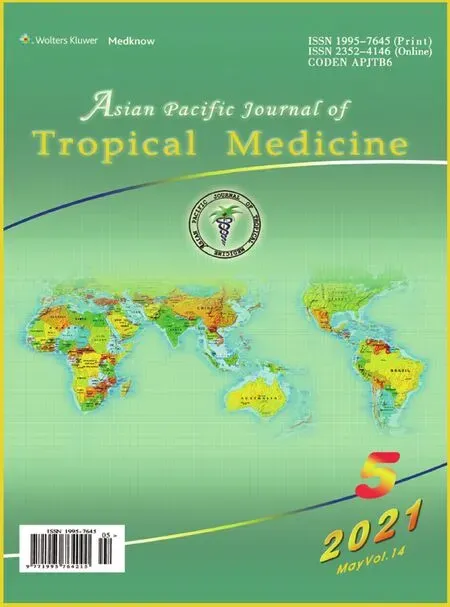 Asian Pacific Journal of Tropical Medicine2021年5期
Asian Pacific Journal of Tropical Medicine2021年5期
- Asian Pacific Journal of Tropical Medicine的其它文章
- Peltzman effect and resurgence of COVID-19 in India
- Leishmania donovani: Immune response and immune evasion with emphasis on PD-1/PDL-1 pathway and role of autophagy
- Circulatory and hepatic failure at admission predicts mortality of severe scrub typhus patients: A prospective cohort study
- Circulation of Brucellaceae, Anaplasma and Ehrlichia spp. in borderline of Iran,Azerbaijan, and Armenia
- Extensively drug-resistant Salmonella typhi causing rib osteomyelitis: A case report
- S gene drop-out predicts super spreader H69del/V70del mutated SARS-CoV-2 virus
